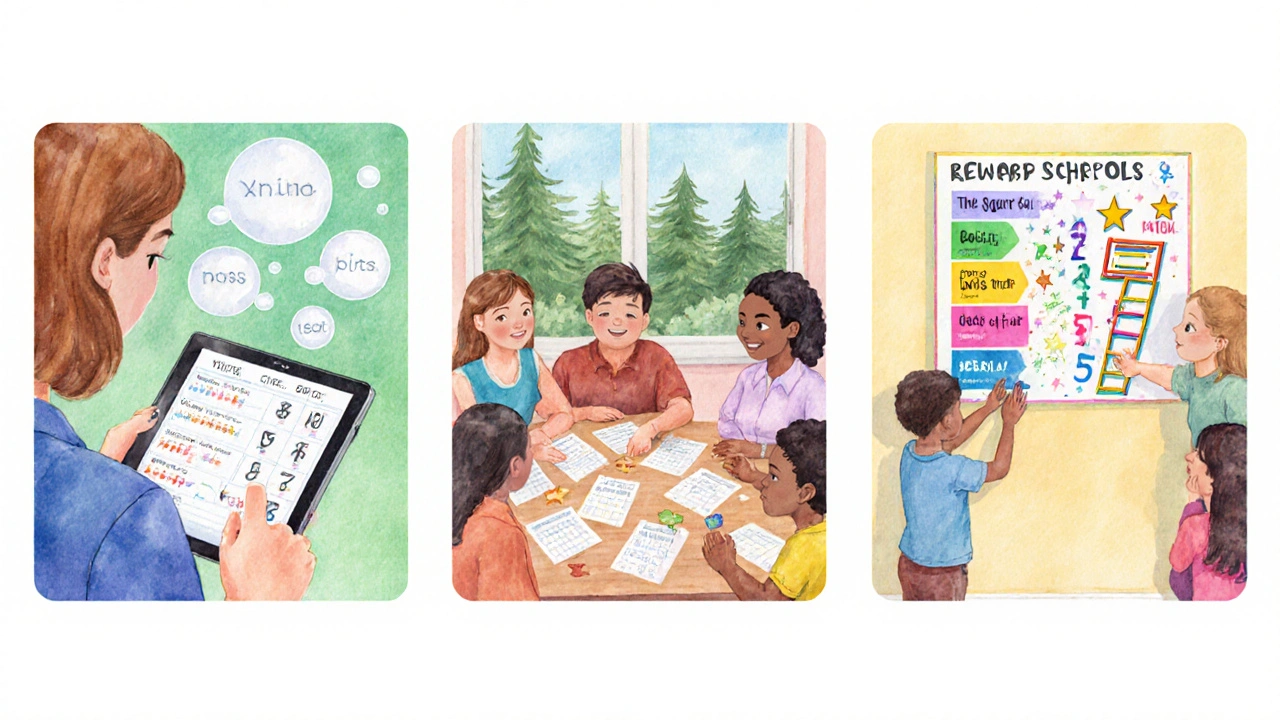TL;DR
- Start with a Functional Behavior Assessment (FBA) to pinpoint why the behavior happens.
- Pick measurable goals and break them into tiny, observable steps.
- Use positive reinforcement and clear consequences consistently.
- Collect data every day and review weekly to see what’s working.
- Adjust the plan based on data, not guesswork.
When a child keeps acting out, parents and teachers often feel stuck. The good news? A solid behavior plan can turn chaos into predictability. Below you’ll get the exact roadmap you need-no fluff, just practical steps you can start using this week.
Understanding the Child’s Unique Situation
Before any paperwork, get a clear picture of the child’s daily life. Talk to parents, teachers, and the child if possible. Ask simple questions like, “What’s the hardest part of the day?” and “When does the problem behavior start?” These answers shape the whole plan.
Conducting a Functional Behavior Assessment
Functional Behavior Assessment is a systematic process that identifies the trigger (antecedent), the behavior itself, and the consequence that keeps it going. In other words, it answers the why. You’ll need three tools:
- Interview & questionnaire: Gather insights from everyone who sees the child daily.
- Direct observation: Watch the child for at least two full days, noting what happens right before and after the behavior.
- Data charting: Use a simple ABC (Antecedent‑Behavior‑Consequence) sheet to capture patterns.
The result is a clear hypothesis, such as “When the classroom gets noisy, Sam shuts down and throws objects to escape the task.” That hypothesis drives every later decision.
Designing the Core Components of the Plan
Now that you know the why, build the what.
1. Set Specific, Measurable Goals
Vague goals like “behave better” won’t cut it. Aim for observable statements: “Reduce classroom outbursts from five to one per day within two weeks.”
2. Choose Positive Reinforcement Strategies
Positive reinforcement is a technique that adds a desirable consequence immediately after the target behavior, increasing the odds it repeats. Pick rewards the child truly values-stickers, extra playtime, or a choice of activity. Keep it immediate (within 5 seconds) and specific (“Great job staying seated for five minutes!”).
3. Establish Data Collection Methods
Data collection is the backbone of any effective plan. Use a simple tally sheet or a digital app to record each instance of the target behavior and each successful replacement. Consistency is key; everyone who works with the child must use the same sheet.
4. Develop Intervention Strategies
Intervention strategy refers to the concrete steps you’ll take to change the environment or teach new skills. Common categories include:
- Antecedent modifications: Reduce triggers (e.g., give clear warnings before transitions).
- Skill building: Teach coping tools like deep breathing or self‑talk.
- Environmental supports: Use visual schedules, noise‑reducing headphones, or seating cushions.
5. Build a Progress‑Monitoring Routine
Progress monitoring is a scheduled review of data to see if goals are being met and to decide when to tweak the plan. Aim for weekly team meetings (teacher, therapist, parent) to discuss trends and adjust reinforcement or antecedent changes.
The Written Behavior Plan Document
Keep the written plan short-no more than two pages. Include these sections:
- Student profile: Age, grade, diagnosis (e.g., ADHD, ODD).
- Functional behavior assessment summary: Brief hypothesis of trigger‑behavior‑consequence.
- Target behavior(s): Exact, observable description.
- Goal(s): Measurable outcomes with timelines.
- Intervention details: Antecedent changes, teaching methods, reinforcement schedule.
- Data collection plan: Who collects, what tool, how often.
- Progress‑monitoring schedule: Review dates and responsible adults.
Use plain language-parents shouldn’t need a degree to understand it.

Implementing the Plan with Stakeholders
Success hinges on everyone being on the same page. Hold a short training session (15‑20minutes) for teachers, aides, and parents. Walk through the ABC sheet, demonstrate the reinforcement timing, and rehearse the new routine. Provide a quick‑reference cheat sheet that lists the target behavior, the reward, and the data‑logging method.
Monitoring, Adjusting, and Celebrating Success
After two weeks, pull the data. Ask yourself:
- Is the frequency of the problem behavior dropping?
- Are replacement skills emerging?
- Do any antecedent changes need tweaking?
If numbers aren’t moving, tweak one component at a time-maybe switch the reinforcement schedule from continuous to intermittent, or add a visual cue before transitions. Celebrate every small win with the child and the team; positive acknowledgment fuels motivation.
Common Pitfalls and Pro Tips
Even seasoned professionals stumble. Here’s what to watch out for:
- Vague descriptions: “Gets angry” is useless. Use “throws a pencil within 10seconds of being told to tidy up.”
- Inconsistent data: If one teacher logs but another doesn’t, the picture is distorted. Assign a single data‑keeper for each setting.
- Over‑punishing: Punishment alone rarely changes behavior and can damage relationships. Pair any consequence with a clear, positive alternative.
- Skipping the FBA: Jumping straight to rewards without understanding triggers is like treating a fever with a band‑aid.
Pro tip: Use a “behavior‑to‑skill” ladder. For every instance of the problem behavior, identify a tiny skill the child can try instead. Reinforce the skill, not the absence of the bad behavior.
Quick Reference Checklist
| Component | What to Include | Who Owns It |
|---|---|---|
| Functional Behavior Assessment | Trigger, behavior, consequence hypothesis | Behavior analyst or special ed teacher |
| Specific Goal | Observable, measurable, time‑bound | Team |
| Positive Reinforcement | Reward type, timing, schedule | Teacher & parent |
| Data Collection | ABC sheet or digital log | All staff |
| Intervention Strategy | Antecedent tweaks, skill‑teaching, environmental supports | Therapist |
| Progress Monitoring | Weekly review, data charts | Team lead |
Frequently Asked Questions
What exactly is a behavior plan?
A behavior plan is a written guide that outlines why a child behaves a certain way, sets clear goals, and lists the strategies-reinforcement, skill teaching, environmental changes-to help the child meet those goals while tracking progress.
How long does it take to develop a solid plan?
If you conduct a thorough Functional Behavior Assessment, you can draft a basic plan in 3-5 days. Fine‑tuning happens over weeks as data rolls in.
Who should be involved in the planning process?
Key players are the child’s parents or guardians, the classroom teacher, a special‑education or behavior specialist, and any therapist who works with the child (speech, occupational, etc.). Everyone’s input shapes the hypothesis and the interventions.
What are the best ways to collect data?
Start with a simple ABC chart on paper or a free app. Record the time, antecedent, behavior, and consequence for each episode. At the end of the day, tally the frequencies. Consistency across settings (home vs school) provides a complete picture.
When should I adjust the plan?
If after two weeks the data shows no downward trend or the child’s stress level rises, revise one element-perhaps the reinforcement type or the antecedent cue-before overhauling the whole plan.
Creating a behavior plan may feel like a big project, but breaking it into these tidy steps turns chaos into a clear roadmap. With data, consistency, and genuine praise, you’ll see steady improvement-and the child will finally feel supported rather than punished.










Yo, this is the playbook we’ve been waiting for! 🚀
Great rundown, really breaks it down step‑by‑step. I love the emphasis on data‑driven tweaks – that’s where the magic happens. The checklist at the end is a lifesaver for busy teachers. 🌟 Keep spreading the good vibes!
Just a quick note: “step‑by‑step” should be hyphenated, and “where the magic happens” is a bit colloquial but works fine here. Overall, solid grammar and clear flow.
Honestly, anyone still using vague “behave better” goals needs a reality check. You can’t teach ethics by wishful thinking. Get specific or stay clueless.
Totally agree, vague goals waste time. Concrete numbers make progress visible. Keep it simple.
Our children deserve the best strategies, not half‑baked foreign ideas. We must protect our schools from weak imports!
Wow, that’s a bold claim! 🙈 While pride is great, evidence‑based methods work everywhere. Let’s focus on results, not borders.
I’m digging the collaborative tone here – everyone from parents to aides gets a role. The ABC chart is a classic, but the digital tip is fresh. Also, the reminder to keep language plain is spot on. Nice balance of theory and practice.
Simple truth: clear language helps all kids understand expectations. That’s why the checklist works.
Absolutely, plain language bridges gaps between home and school. When parents read the plan, they’re more likely to reinforce it. Consistency is the real game‑changer.
The integration of visual schedules and sensory tools is essential for neurodivergent learners. Embedding jargon such as “antecedent modifications” signals professional rigor, yet the surrounding explanation remains accessible. Moreover, aligning reinforcement timing within a five‑second window optimizes operant conditioning efficacy. The systematic data collection protocol, whether paper‑based or app‑driven, ensures fidelity across settings. Lastly, the emphasis on weekly interdisciplinary reviews fosters collaborative accountability.